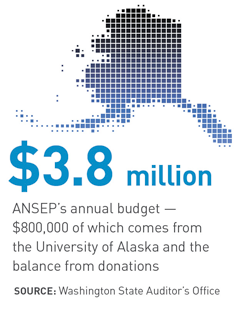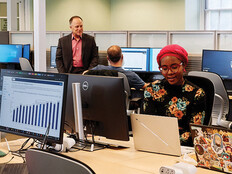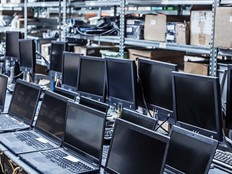Alaska Colleges Sow STEM Seeds for Middle School Students
"Those who know how to play can easily leap over the adversities of life."
That's an Inuit saying that Dr. Herb Ilisaurri Schroeder appears to have taken to heart — his Alaska Native Science & Engineering Program certainly embodies the notion that creative play engages learners.
ANSEP, founded in 1995, helps Alaskan middle and high school students build more than 200 desktop computers each summer during academies hosted at the University of Alaska in Anchorage.
"The idea behind the computer build is to inspire students to take more advanced science and math courses," says Schroeder, ANSEP's vice provost and founder. "I found that many of the students in our Alaskan villages were chronically underprepared in math and science, and I wanted to change that."
To spark that inspiration, high school students who build computers can keep the units if they pass chemistry, physics and trigonometry before they graduate. Middle school students must pass Algebra I by the eighth grade to keep their machines. Today, nearly 80 percent of the students go on to meet this requirement.
Schroeder came up with the idea for ANSEP after working with the the U.S. Office of Technology Assessment in the early 1990s to improve sanitation in Alaska's numerous remote villages. A civil engineer by trade and a professor at the University of Alaska, Schroeder noticed after two years of working in more than 100 villages that he never met an Alaska Native among the engineers taking part in the sanitation project.
He started to investigate why there were so few Alaska Native engineers and found that many administrators and teachers in the villages didn't think the local students were capable of meeting a rigorous science, technology, engineering and math curriculum.
"They didn't encourage the kids to take advanced coursework in math and science and, in many cases, didn't offer STEM courses," Schroeder says. "Unfortunately, these are deeply rooted beliefs, so we had to find a way to inspire the students independent of the schools." He was particularly troubled by the fact that the decline in math and science preparation wasn't a problem limited to Alaska.
Today, he notes, roughly 75 percent of U.S. students entering high school have not completed Algebra I. That means that the vast majority of those students will not complete entry-level Calculus by the time they begin their college years.
"I realized that most of the kids in our country were being set up to come into the university setting underprepared," Schroeder says. "You can't start math in the middle and fix it at the university level. You have to go back as early as you can and inspire kids so they take the coursework they need to be successful when they arrive at the university."
That's why ANSEP launched a middle school academy with support from the ExxonMobil Bernard Harris Summer Science Camp program. Many students who start as middle school students return for additional ANSEP academies in high school.
"With ANSEP, we start with the kids in the sixth grade. We can then be involved with them until they have a graduate degree," Schroeder says. "Many of them come back and are active members of our program as college students."

Computers as Carrots
Students aren't crafting toy computers in these academies, ANSEP Chief Operations Officer Mike Bourdukofsky is quick to note. The students build up-to-date systems. All of the desktops have the latest motherboards, processors and graphics cards and can handle the many video and gaming applications that today's students want to use.
"We build machines that students will be attracted to," he says. "When their friends and siblings see the machines, everyone is blown away that these students have built their own machines."
Most of the desktop systems built during the most recent session have at least an Intel Core i5 chip with a processor speed of 3.30 gigahertz. Students also loaded their machines with 4 gigabytes of DDR3 RAM, a Linksys wireless adapter and a 1 terabyte Seagate SATA hard drive. The basic software setup included a Microsoft Windows 7 operating system and Microsoft Office Home and Student 2010 software package. Students also preconfigured their systems with Autodesk AutoCAD and geographic information systems.
Although students spend much of their time on the computer builds, ANSEP takes advantage of their captive attention to introduce other STEM lessons. For instance, they might study the design and building of structures — learning the physics principals involved in, say, building a small bridge.
The ANSEP academies are so popular with the students that some can't wait to come back and work as counselors or even as program employees. Bourdukofsky is an example. Born and raised on St. Paul Island in the Bering Sea, he worked for ANSEP while earning his degree in engineering at the University of Alaska in 2003. He then worked as a civil engineer before coming to work for ANSEP full time in 2007.
"I saw that they were doing some exciting things with the computer builds," he says. "It just seemed like a cool opportunity to see more of the state and help students who were like me at one point and get them excited about science and engineering."
Josephine Edwards-Vollertsen, ANSEP's regional director, also has school ties to the nonprofit organization. She grew up on the Kenai Peninsula and had a brother who was an ANSEP student and graduated with a degree in civil engineering. Later, as a social sciences student at the university, Edwards-Vollertsen began working part time with the program. "Once I heard about the opportunity, I couldn't wait to join the team," she says.
Lives Changed
To explain the enthusiasm for ANSEP, Schroeder points to what the program's participants are doing today: There's a doctor at the university hospital, managers in the oil and gas industry, and many others working in environmental management at federal and state agencies.
"We're effecting change that wouldn't have been possible 15 years ago," he says. "I feel like we're just getting started. It's only the beginning of what we'll be able to do."








